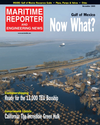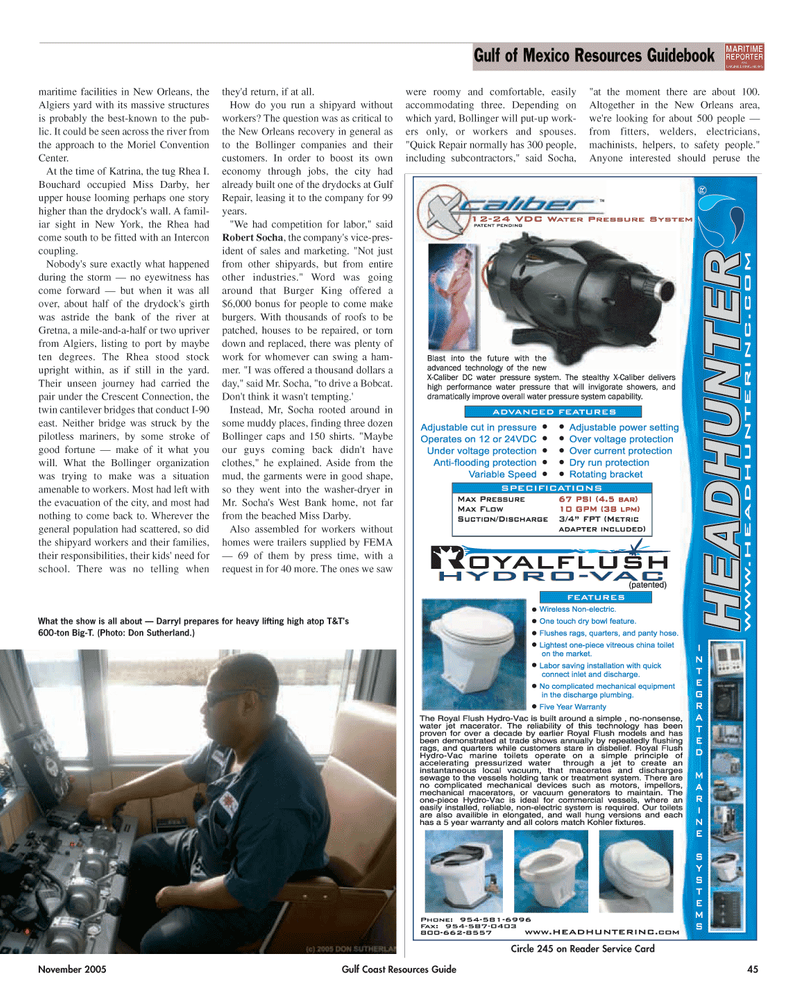
Page 45: of Maritime Reporter Magazine (November 2005)
The Workboat Annual Edition
Read this page in Pdf, Flash or Html5 edition of November 2005 Maritime Reporter Magazine
maritime facilities in New Orleans, the
Algiers yard with its massive structures is probably the best-known to the pub- lic. It could be seen across the river from the approach to the Moriel Convention
Center.
At the time of Katrina, the tug Rhea I.
Bouchard occupied Miss Darby, her upper house looming perhaps one story higher than the drydock's wall. A famil- iar sight in New York, the Rhea had come south to be fitted with an Intercon coupling.
Nobody's sure exactly what happened during the storm — no eyewitness has come forward — but when it was all over, about half of the drydock's girth was astride the bank of the river at
Gretna, a mile-and-a-half or two upriver from Algiers, listing to port by maybe ten degrees. The Rhea stood stock upright within, as if still in the yard.
Their unseen journey had carried the pair under the Crescent Connection, the twin cantilever bridges that conduct I-90 east. Neither bridge was struck by the pilotless mariners, by some stroke of good fortune — make of it what you will. What the Bollinger organization was trying to make was a situation amenable to workers. Most had left with the evacuation of the city, and most had nothing to come back to. Wherever the general population had scattered, so did the shipyard workers and their families, their responsibilities, their kids' need for school. There was no telling when they'd return, if at all.
How do you run a shipyard without workers? The question was as critical to the New Orleans recovery in general as to the Bollinger companies and their customers. In order to boost its own economy through jobs, the city had already built one of the drydocks at Gulf
Repair, leasing it to the company for 99 years. "We had competition for labor," said
Robert Socha, the company's vice-pres- ident of sales and marketing. "Not just from other shipyards, but from entire other industries." Word was going around that Burger King offered a $6,000 bonus for people to come make burgers. With thousands of roofs to be patched, houses to be repaired, or torn down and replaced, there was plenty of work for whomever can swing a ham- mer. "I was offered a thousand dollars a day," said Mr. Socha, "to drive a Bobcat.
Don't think it wasn't tempting.'
Instead, Mr, Socha rooted around in some muddy places, finding three dozen
Bollinger caps and 150 shirts. "Maybe our guys coming back didn't have clothes," he explained. Aside from the mud, the garments were in good shape, so they went into the washer-dryer in
Mr. Socha's West Bank home, not far from the beached Miss Darby.
Also assembled for workers without homes were trailers supplied by FEMA — 69 of them by press time, with a request in for 40 more. The ones we saw were roomy and comfortable, easily accommodating three. Depending on which yard, Bollinger will put-up work- ers only, or workers and spouses. "Quick Repair normally has 300 people, including subcontractors," said Socha, "at the moment there are about 100.
Altogether in the New Orleans area, we're looking for about 500 people — from fitters, welders, electricians, machinists, helpers, to safety people."
Anyone interested should peruse the
Circle 245 on Reader Service Card
Gulf of Mexico Resources Guidebook
MARITIME
REPORTER
AND
ENGINEERINGNEWS
November 2005 Gulf Coast Resources Guide 45
What the show is all about — Darryl prepares for heavy lifting high atop T&T's 600-ton Big-T. (Photo: Don Sutherland.)
MR NOVEMBER 2005 #6 (41-48).qxd 10/28/2005 10:15 AM Page 45

 44
44

 46
46
